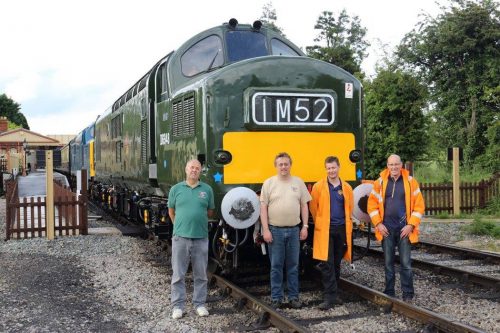Background
The D6948 story started back in the early 2000s when four Growler Group committee members decided to privately purchase a class 37 in addition to looking after the Group’s own loco, 37215, with a view to running it on the main line. The chosen machine, 37158, was duly purchased and a deal to hire the loco was done with West Coast Railways who at the time were keen to acquire diesel traction via operational leases to support their growing business.
During the overhaul process, and with the approval of the 4 owners, 37158 was replaced by WCRC with 37248 sourced from the scrap line at Margam in 2005. After an overhaul at Carnforth, WCRC put the loco into traffic on 10th August 2006 and for the next 3 years it was used intensively throughout the UK from Mallaig to Kent. By 2009 with WCRC acquiring its own 37 fleet and the loco starting to see less use, mutual agreement was reached with WCRC for the termination of the lease and return of the loco to the owners, and on the 12th May 2009, 57601 duly delivered 248 to the GCR(N) at Ruddington, who had kindly offered to provide a temporary home whilst a permanent base was sought.
The loco took part in the GCR(N)’s May 2009 gala immediately after and took advantage of the mainline connection to visit the 2009 Midland Railway Centre and East Lancs Railway galas. Given the owners’ links to the GWR at Toddington through 25+ years of work on the railway, 37215 and the Growler Group, it was decided to approach the GWR for a permanent home and fortunately this succeeded subject to a number of conditions….
As part of the Agreement for Toddington and the GWR to become its permanent home, it was agreed that 37248 would be fully restored to 1964 ‘as built’ condition, including a re-paint into BR green and the installation of a steam heating boiler/generator, to allow it to work trains during the winter months. This included bodywork repairs, removal of post-1960s equipment and fittings, modifications to fuel tanks, new pipework and new buffer beam skirts together with a mechanical and electrical overhaul. Although ballast weights were mounted in place of the boiler, we now know that a boiler was not actually fitted when the locomotive entered service.
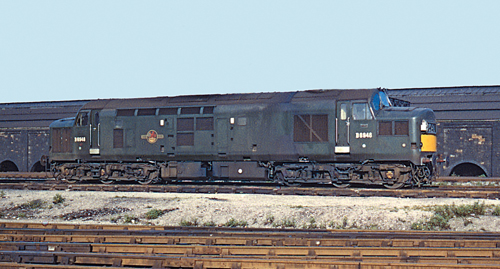
After a final appearance at the GCR(N) at their October 2009 gala event, 37248 was transferred by road to Toddington a few days later and was put straight into service on the 16:35 Toddington-Cheltenham Racecourse and 17:20 return service on the 18th October. Further use followed at the GWR’s diesel galas in October 2009 and March 2010, and the Christmas Diesel Day. In April 2010, the first of two major embankment collapses on the GWR occurred, resulting in a sudden demand for diesels to top and tail the steam fleet meaning 37248 was needed to take its share of the increased burden on the diesel fleet throughout the remainder of the 2010 season.
The Project
‘Project D6948’ commenced and the locomotive formally taken out of service in January 2011 to make a start on creating a unique locomotive in UK preservation.
‘Project D6948’ consisted of the following stages:
- Installation of steam heating capability.
- Remove ballast weights and prepare boiler room area.
- Acquire and install an operational steam heating boiler/steam generator including electrical control system.
- Retro-convert one fuel tank back to a boiler water tank.
- Prove and if necessary install boiler control wiring from cabs to electrical cubicle.
- Fit new steam pipework.
- Fit new boiler water feed and fuel feed pipework.
- Acquire and install buffer beam steam heat fittings and connections.
- Attend to outstanding mechanical faults – cylinder head overhaul and timing chain.
- Clean and refurbish the electrical cubicle area.
- Installation of a modern ‘solid state’ electronic Automatic Voltage Regulator (AVR) to help ensure the reliability of batteries and auxiliary equipment by delivering a precisely controlled design voltage and eliminate the variability associated with the old 1960s carbon-pile design.
- Remove all redundant post-1960s equipment (OTMR, TPWS, AWS, Headlights, NRN radio, aerials etc).
- Acquire and fit buffer beam skirts.
- Cut out headcode panels and refit working headcode blinds.
- Bodywork repairs – cut out and weld in new steel where needed. Prepare for painting.
- Full re-paint in BR green with grey roof to a high quality finish including half-size yellow warning panels.
- Fit D6948 numbers, WR ‘blue’ RA roundels and ‘86A’ shed-plates.
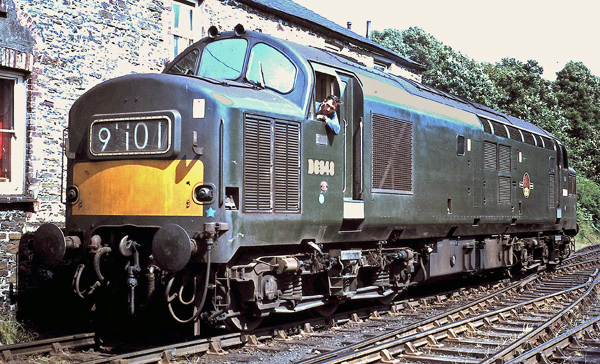
The steam ‘boiler’
After assessing the options available for purchasing and fitting a modern steam generator, in conjunction with our partner in the project VAS Engineering of Bridgwater, the decision was taken to assess the three scrap ex-class 37 Clayton steam generators acquired many years ago, which had been in open storage at Toddington. This was primarily due to the design being specific to the available space inside the class 37 body.
Arrangements were therefore made to move the three steam generators to the workshops of VAS for strip down and a detailed condition assessment, which fortunately resulted in the positive news that it was possible to rebuild one re-conditioned unit from the available parts. Repairs to the steam generator coil found to be in the best condition and subsequent pressure tests proved positive, and following design and fitting a new modern equivalent electrical control system, and replacement/refurbishment of various mechanical parts, the unit was steamed for the first time in early June. It passed its insurance inspection and received the appropriate certification on the 9th June 2011.
In parallel, work has been ongoing in preparing the boiler area of the loco, including a lift out of the two substantial cast ballast weights which were fitted to replace the weight of the boiler. These were finally removed on the 26th June. Preparatory work has also taken place outside, steam cleaning underneath the body where new steam pipework will need to be installed.
With the loco moved inside the David Page Shed at Toddington in early June, the roof over the boiler compartment was removed ready for installation of the boiler, which took place on the 10th August 2011.
As the loco had the original boiler water tank converted to an additional fuel tank to improve range, one important and not very easy task was to blank this off, drain it of fuel and convert it back. Feed pipework was then installed to connect the new boiler water and fuel tank to the new boiler. With this done and with the necessary electrical connections made in the loco’s cubicle and boiler panel, the boiler was started for the first time on the 6th November 2011 and produced steam successfully.
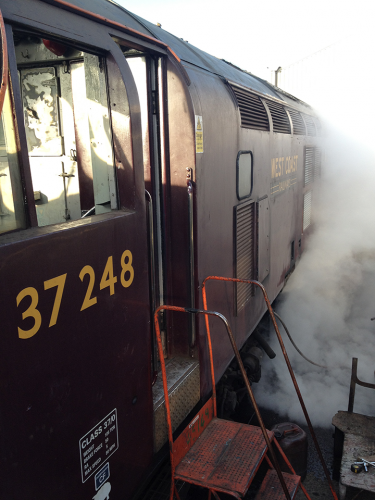
The rest of the work inside
The first jobs included refurbishing the interior of the engine room particularly at the end where the new boiler would be installed. The engine room really was in a dreadful state due primarily to a leaking exhaust which had liberally coated the inside with sticky soot deposits. Removing the ballast weights in the boiler area also required the removal of the TPWS and OTMR systems which occupied the space, together with what seemed like miles of cabling.
At the same time, some external and internal cab side bodywork was cut out and new sections welded in. Windows were removed from the cabs and modern additions such as the NRN aerial and headlight were removed and the plated-over headcode panels cut out. The oval buffers were also replaced with the correct round versions and Western Region lamp brackets fitted and welded into place. A design for the original bodyside/nose end skirts was obtained and laser-cut by the supplier, before being welded into place and beading applied to finish.
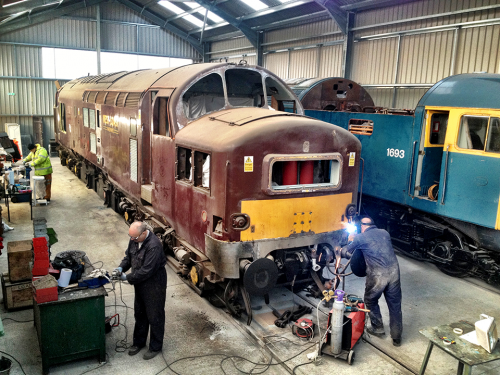
A new electronic Automatic Voltage Regulator (AVR) was installed on the 31st July 2011.
As time passed into 2012, work started on stripping and refurbishing the cabs. Both had all their equipment removed and were needle-gunned back to bare metal, primed, undercoated and finally finished off in grey gloss. It was decided not to apply the original dark green and cream colour scheme inside the cabs simply because we felt it far too gloomy in which to spend time in and opted for the later light grey scheme. Other jobs undertaken at the same time included cutting away part of the bodyside to reveal the original hand-holds for accessing the boiler water chute, and re-installing the hatch for accessing the chute itself. This allowed the water tanks to be refilled using a steam-era water crane at the platform end although the chute itself was not refitted inside the loco as they were known for spilling water inside the engine room! A more modern low level hose connector will be fitted instead.
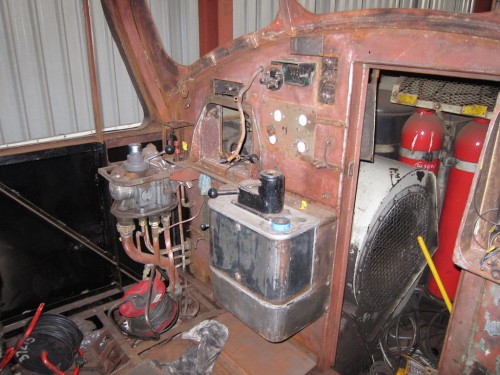
The radiator tunnels between the engine room and no.1 cab were also refurbished at both sides removing a lot of corrosion. Back in the cabs, new ceiling panels were made and refitted together with a new floor. All internal and external doors together with roof and nose hatches were also removed, needle gunned back to bare metal and re-sprayed ready for re-fitting. This also included all the electrical cubicle doors and the frame re-painted. In the buffer beam area, various air pipes and their connections had to be relocated to allow the skirts to be fitted, and new fittings made which included the installation of new steam heat connections and associated fittings at both ends. The various body side grilles, sandboxes and handholds were also needle gunned.
The exterior
Over the winter of 2012/13, work started on the external needle gunning of the bodywork and the removal of large amounts of filler with both noses stripped back to bare metal. As 2013 drew on, the long, tedious job of needle gunning the entire bodysides progressed finally saw off the last of the WCRC maroon, followed by doing the same to the bogies, and anything below the sole bar such as the fuel and water tanks and the roof.
Into 2014, and work continued on the long job of sanding and filling the body sides and nose ends following which the loco received several coats of high build primer. After each application there was further filling and sanding to achieve a smooth finish. The bogies and water/fuel tanks were sprayed black and new headcode panels and metal surrounds fitted followed by refurbished headcode boxes and the winding mechanisms following re-painting inside the nose ends. In parallel, we were extremely fortunate to enlist the services of steam department volunteer and pipework specialist, Neil Cooper, who completed the challenging task of installing the large diameter main steam pipe underneath the loco connecting the boiler outlet to the new fittings on each buffer beam which was then lagged in situ. Following a thorough clean under the floor in the cabs, rotting pipework was replaced where required and new flexible pipes fitted to feed the instrument panels.
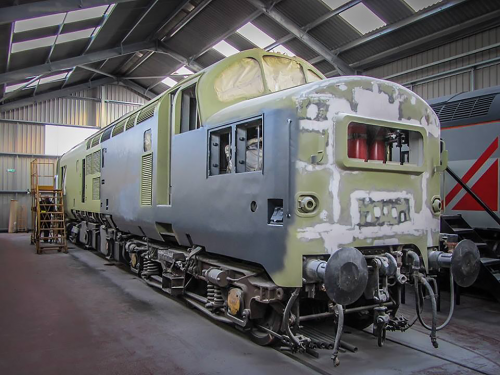
As we moved into 2015, the cycle of filling, sanding and primer was finally completed and when the summer arrived it was time to apply the first of several top coats. Firstly the grey roof was sprayed and then the nose and bodysides finished off in green gloss together with the application of yellow half warning panels on each nose. Warning flashes, numbers, British Railways lion and wheel logo, Western Region blue route availability spots, shed, works and kick plates, and headcode roller blinds were fitted to complete the exterior finish of the loco.
With the end in sight (or so we thought) new batteries were purchased and installed following the refurbishment of the battery box area. Further internal painting was carried out in the nose ends, fan room and engine compartment and a faulty exhauster replaced, whilst the fire bottles were being refilled and certified. Cab instrumentation was refitted and the seats re-upholstered in traditional red leatherette by our friends in Winchcombe Carriage & Wagon works. The electrical cubicle, vital to the correct operation and control of the locomotive, was checked and cleaned to remove as much dust and accumulated debris as possible.
The power unit – a partial overhaul needed
The focus then moved to the power unit and fixing what was thought to be a relatively small issue with the power unit – adjusting the tension of the power unit timing chain, situated on the generator end linking the A and B camshaft banks to the crankshaft. However, during detailed checks on the chain tension it soon became clear that something was amiss. After sourcing a replacement brand new timing chain, the existing timing chain was cut and dragged out of the power unit and the problem became apparent – the existing chain securing pin had sheared off. With a temporary pin and new chain in place, detailed inlet cam lift timing checks were undertaken which then unfortunately revealed an unacceptable difference in timing between B1 and B6 pistons. There was no alternative but to strip down the entire top end of the power unit to gain access to the various cam followers which in turn revealed that the B1/2 camshaft section was twisted and had to be replaced. In removing the fuel pumps to do this, it revealed that two were defective so it was decided to have them all sent away for overhaul together with all the fuel injectors. Finally, in early 2016 the power unit was re-assembled and was started on 10th April 2016.
The end at last!
Finally, in early 2016 the power unit was re-assembled and was successfully started on 10th April 2016.
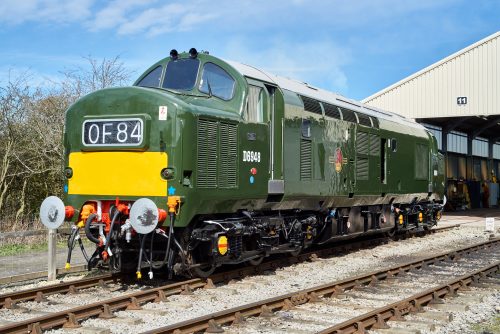
A period of testing and fault finding followed – a couple of electrical issues were resolved as the loco wouldn’t take power at first, and it became clear that hardly any control air was making it to the driver’s power controller and hence the engine speeder valve. Some new pipework to bypass the problem provided a solution and light engine test runs on the 2nd and 22nd May, followed by a full ‘B’ exam and finally by a loaded test to Cheltenham on 12th June in company with 37215, marked the loco’s return to service – 5 years and 5 months after ‘Project D6948’ began.
There is no doubt that the discovery of these engine problems near the end of the project set it back significantly but the resulting partial ‘top end’ overhaul will be a beneficial investment for the future. Together with the discovery of control air supply problems, the mystery of its low power and ‘chitty’ nickname whilst on the mainline seems to have been solved, as under test the loco appeared to be both strong and responsive.
On reflection, it was a difficult and expensive project which has pushed both owners and key volunteers to the limit at times. But the result was a Western Region green steam heat fitted class 37 just as it was delivered in 1964 (part from train air braking being fitted). It has become a reliable member of the GWR’s diesel fleet and in 2019 made a very successful visit to the West Somerset Railway running 870 trouble-free miles.
